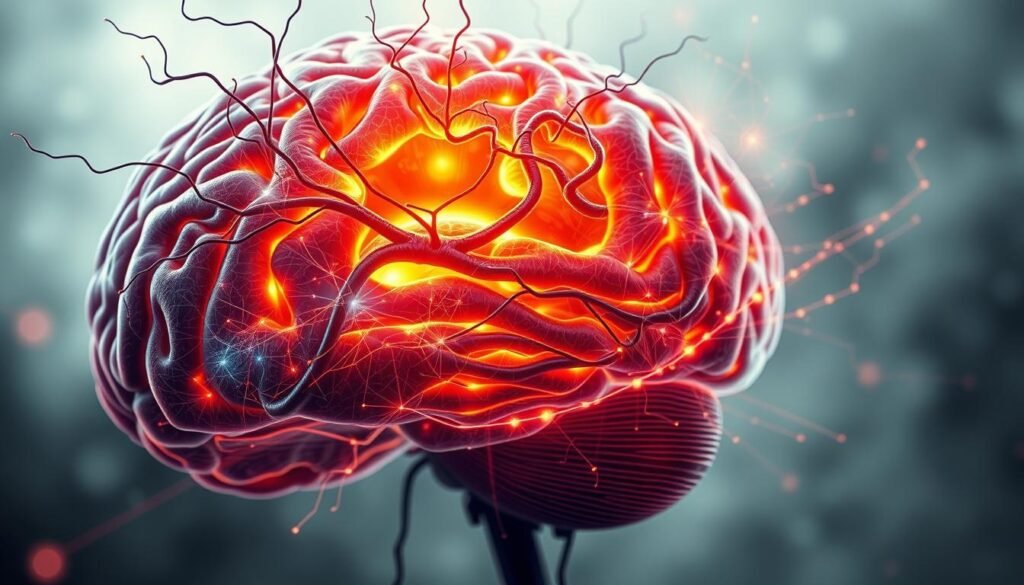Have you ever felt an overwhelming fear of being judged in everyday social situations? This isn’t just shyness—it could be a sign of a deeper mental health challenge. Social anxiety disorder (SAD) affects millions of people, making even simple interactions feel daunting.
This condition is more than just nerves. It’s a chronic issue that can disrupt daily life. Studies show that 7.1% of U.S. adults experience it yearly, with women being twice as likely to face it. The good news? Effective treatments like therapy and medication can help manage symptoms.
In this article, we’ll explore the signs, causes, and proven treatments for this condition. Whether you’re seeking answers for yourself or a loved one, understanding is the first step toward healing.
Key Takeaways
- Social anxiety disorder affects 7.1% of U.S. adults annually.
- It’s more than shyness—it causes significant life impairment.
- Women are twice as likely to experience it compared to men.
- Most diagnoses occur before the age of 23.
- Treatments like CBT and medication have a 75-80% success rate.
What is Social Anxiety Disorder?
Do you avoid social gatherings due to an intense fear of judgment? This could be a sign of social anxiety disorder, a condition that goes beyond typical nervousness. According to the DSM-5, it involves persistent fear lasting six months or more, significantly impacting daily life.
Unlike the occasional jitters before public speaking, this disorder creates overwhelming distress in everyday social situations. For example, someone might dread casual conversations or avoid group activities entirely. This fear stems from a deep worry about being negatively evaluated by others.

There are three main types of this condition. Generalized social anxiety affects most social contexts, while performance-only anxiety is limited to situations like public speaking. Nongeneralized anxiety is triggered by specific scenarios, such as eating in front of others.
Research shows that the brain plays a key role in this condition. The amygdala, which processes fear, becomes hyperactive. At the same time, the prefrontal cortex, responsible for rational thinking, struggles to regulate these emotions. This imbalance fuels the intense fear experienced.
Often, this condition begins in childhood as shyness and escalates during adolescence. Early recognition and intervention can make a significant difference in managing symptoms and improving quality of life.
Signs and Symptoms of Social Anxiety Disorder
Does the thought of interacting with others fill you with dread? For many, this isn’t just a passing worry—it’s a persistent struggle. Recognizing the signs is the first step toward understanding and managing this condition effectively.

Physical Symptoms
Physical reactions often accompany the fear of social interactions. These can include sweating, trembling, a racing heart, or even nausea. For some, these symptoms are so intense that they avoid situations altogether. Over 84% of people report anticipatory anxiety, which can start weeks before an event.
Emotional Symptoms
Emotionally, the condition can feel overwhelming. Many experience intense emotional symptoms, such as shame spirals or hypersensitivity to rejection. The mind may spiral into cognitive distortions, like mind-reading (“They think I’m stupid”) or catastrophizing. These patterns can lead to avoidance behaviors or post-event rumination, where individuals replay interactions in their mind, fearing judgment from others.
Additionally, this condition often coexists with other challenges. Studies show that 60% of individuals also struggle with depression, while 30% face substance abuse issues. The impact on daily life is significant, with 34% experiencing severe educational impairment and 28% facing work disability.
Causes of Social Anxiety Disorder
What drives the intense fear of social interactions in some individuals? Research points to a mix of genetics, brain activity, and environmental factors. Understanding these causes can help in addressing the root of the issue.
Studies show that genetics play a significant role. The heritability rate is between 30-40%, meaning if a close family member has this condition, your risk increases threefold. Specific genetic markers, like variants in the SLC6A4 serotonin transporter gene, are linked to heightened sensitivity to stress.

The brain also plays a crucial part. Neuroimaging studies reveal hyperactivity in the amygdala during social tasks. This area, responsible for processing fear, becomes overactive, while the prefrontal cortex struggles to regulate emotions. This imbalance fuels the intense discomfort experienced.
Environmental triggers are equally important. Childhood bullying, for example, has a 57% correlation with the development of this condition. Overprotective parenting can also delay the acquisition of social skills, making it harder to navigate interactions later in life.
Negative social experiences often create a maintenance cycle. Avoidance behaviors reinforce the fear, making it harder to break free. Early recognition and intervention can help disrupt this cycle and improve outcomes.
How is Social Anxiety Disorder Diagnosed?
Are you struggling with persistent fear in everyday interactions? Diagnosing this condition involves a thorough evaluation by a healthcare provider. On average, there’s a 10-year delay between the onset of symptoms and an official diagnosis. Early recognition is crucial for effective management.
The process begins with a differential diagnosis. Conditions like thyroid disorders, Parkinson’s disease, and substance use must be ruled out. This ensures the symptoms aren’t caused by other medical issues. Accurate diagnosis is the foundation of proper treatment.

Assessment tools play a key role. The Liebowitz Social Anxiety Scale (LSAS) and Mini-SPIN screening are commonly used. These tools help measure the severity of the condition. A clinical interview is also conducted, focusing on symptom duration, functional impairment, and avoidance patterns.
Comorbidity is another factor to consider. Around 70% of individuals with this condition also have additional mental health challenges, such as mood disorders. Cultural considerations are important too. Presentation can vary between collectivist and individualist societies, affecting how symptoms are expressed and understood.
Diagnosis follows the criteria outlined in the DSM-5. This includes persistent fear lasting six months or more, significant life impairment, and avoidance of social situations. A comprehensive approach ensures an accurate diagnosis and paves the way for effective treatment.
Treatment Options for Social Anxiety Disorder
Managing intense fear in social settings requires effective treatment strategies. With the right approach, individuals can regain control and improve their quality of life. Treatment typically involves a combination of psychotherapy and medication, tailored to individual needs.

Psychotherapy
Psychotherapy is a cornerstone of treatment. Cognitive Behavioral Therapy (CBT) is particularly effective, helping individuals challenge and change negative thought patterns. Exposure therapy, a subset of CBT, gradually reduces fear by facing social situations in a controlled manner.
Studies show that CBT has a success rate of 75-80%. It equips individuals with practical tools to manage symptoms and build confidence. Regular sessions with a trained therapist can lead to significant improvements over time.
Medication
Medication can also play a crucial role in managing symptoms. SSRIs, such as escitalopram (Lexapro), are often the first-line treatment. These medications help regulate serotonin levels in the brain, reducing anxiety. Paroxetine is another FDA-approved option for this condition.
For those who don’t respond to SSRIs, SNRIs may be considered. Beta-blockers, like propranolol, are effective for performance anxiety, reducing physical symptoms in 89% of cases. Benzodiazepines can provide short-term relief but carry a risk of dependence, with 23% of long-term users developing reliance.
Adjunctive options, such as gabapentin, are available for treatment-resistant cases. Pharmacogenomic testing can also guide treatment by analyzing how individuals metabolize medications like SSRIs.
Living with Social Anxiety Disorder
Navigating daily life with intense fear in social settings can feel overwhelming, but there are strategies to help. From improving sleep to building social skills, small changes can make a big difference. Regular aerobic exercise, for example, has been shown to improve symptoms by 40%.

Daily management is key. Practicing sleep hygiene protocols and diaphragmatic breathing can reduce stress. These techniques help calm the mind and body, making it easier to face challenging situations.
Building social skills is another important step. Joining groups like Toastmasters or scripting conversations can boost confidence. These activities provide a safe space to practice and improve interactions.
In the workplace, accommodations like flexible presentation formats can ease stress. The ADA offers protections to ensure individuals feel supported in their professional environments.
Maintaining healthy relationships is also crucial. Disclosure scripts and partner education resources can help loved ones understand and provide the right support.
Finally, relapse prevention is essential. Identifying early warning signs and having a crisis plan in place can help manage setbacks. With the right strategies, it’s possible to lead a fulfilling life.
Support Groups and Resources
Finding the right support can make a significant difference in managing daily challenges. Over 300 U.S.-based support groups are available, with a 62% member satisfaction rate. These groups provide a safe space to share experiences and learn coping strategies.
National organizations like the Anxiety & Depression Association of America (ADAA) offer valuable resources. Peer platforms such as SMART Recovery and the 7 Cups online community connect individuals with others facing similar struggles.
Government resources are also available. The NIMH provides a toolkit specifically for this condition, while the SAMHSA helpline offers immediate assistance. These tools are designed to help individuals navigate their journey effectively.
Specialized programs, such as workplace workshops and college student support, address unique needs. These initiatives focus on building confidence and reducing stress in specific environments.
When choosing a group, it’s important to avoid those promoting avoidance behaviors. Instead, seek out programs that encourage active participation and skill-building. With the right resources, managing daily life becomes more achievable.
How to Support Someone with Social Anxiety Disorder
Supporting a loved one through challenging times requires understanding and compassion. Many individuals face stigma from their family, with 68% reporting negative experiences. Proper support can increase treatment adherence threefold, making a significant difference in their journey.
Effective communication is key. Use validating language and ask open-ended questions to create a safe space. This approach fosters trust and encourages them to share their feelings without fear of judgment.
Balancing accommodation is crucial. Gradually expose them to challenging situations while avoiding enabling avoidance behaviors. This helps them build confidence and resilience over time.
In moments of crisis, recognizing panic attack signs is essential. Grounding techniques, such as deep breathing or focusing on the present, can help them regain control. Being prepared for these situations shows your empathy and readiness to assist.
Collaborative care can also be beneficial. With their consent, attend therapy sessions to better understand their needs and progress. This involvement demonstrates your commitment to their well-being.
Finally, setting boundaries is important. While supporting them, ensure you maintain your own mental health. This balance allows you to provide consistent care without burning out. With patience and understanding, you can make a meaningful impact in their life.
Preventing Social Anxiety Disorder
Taking proactive steps can help reduce the risk of developing intense fear in social settings. Prevention starts with early intervention, especially during childhood. Programs like social skills training for kids aged 8-12 can build confidence and resilience.
Schools play a vital role in prevention. Anti-bullying initiatives and growth mindset curricula have shown positive results. Studies reveal that school-based CBT programs reduce the incidence of this condition by 40% in at-risk youth.
Parenting strategies also matter. Reducing criticism can lower the risk by 52%. Coaching parents to foster a supportive environment helps children feel more secure in social situations.
Workplace and community programs are equally important. Presentation skills training for employees and public speaking workshops for teens can build confidence. These initiatives create opportunities for individuals to practice and improve their interactions.
Effective stress management techniques, such as mindfulness and relaxation exercises, can also help. By addressing potential triggers early, it’s possible to create a foundation for healthier social experiences.
Conclusion
Taking the first step toward understanding and managing this condition can lead to significant improvements. Combining treatment effective methods like CBT and medication has shown an 80% success rate. Early intervention is crucial, as delays in seeking help can prolong challenges.
If you or someone you know is struggling, resources like the NIMH Find Help tool and ADAA therapist directory are excellent starting points. With proper support, 45% achieve full remission, and 35% see significant improvement.
Recovery is a journey, but it’s one filled with hope. Many have overcome these challenges and gone on to lead fulfilling lives. The key is to seek help and take that first step toward healing.
FAQ
What is social anxiety disorder?
It’s a mental health condition where individuals experience intense fear or discomfort in social situations. This can include speaking in public, meeting new people, or being in group settings.
What are the common signs of this condition?
Signs include physical symptoms like sweating or a racing heart, and emotional symptoms such as excessive worry or fear of judgment. These often occur in social settings.
What causes this type of anxiety?
Causes can include genetics, brain chemistry, and environmental factors like past trauma or negative experiences in social interactions.
How is it diagnosed?
A mental health professional evaluates symptoms, often using criteria from the DSM-5. They may also assess how these symptoms impact daily life.
What treatments are available?
Treatment options include psychotherapy, such as cognitive behavioral therapy (CBT), and medications like selective serotonin reuptake inhibitors (SSRIs) or serotonin-norepinephrine reuptake inhibitors (SNRIs).
Can lifestyle changes help manage symptoms?
Yes, regular exercise, healthy sleep habits, and stress management techniques can improve overall well-being and reduce symptoms.
Are there support groups for this condition?
Yes, many organizations and online communities offer support groups where individuals can share experiences and coping strategies.
How can I support someone with this condition?
Offer understanding, encourage them to seek professional help, and avoid pressuring them into uncomfortable situations. Patience and empathy are key.
Can this condition be prevented?
While it may not always be preventable, early intervention, building self-confidence, and fostering positive social experiences can reduce the risk.






